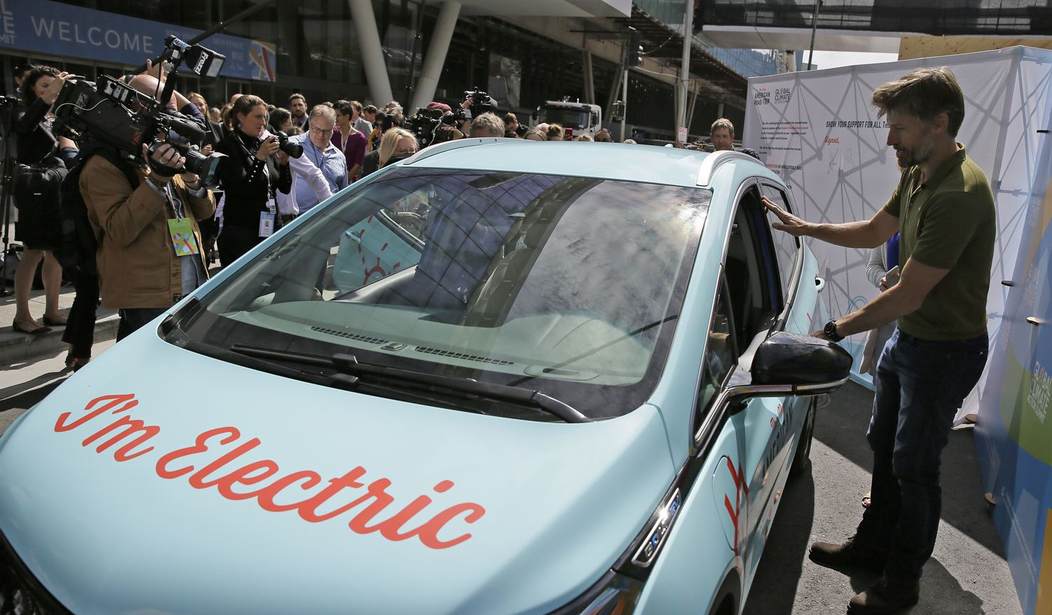Hint: It’s not fossil fuels. It’s not nuclear power. It’s not even wind or solar, although the state will undoubtedly keep expanding both.
The answer? California’s largest electric utility PG&E wants to suck the batteries of electric-vehicle owners plugged into charging stations to stabilize the grid during unstable periods. The Ford F-150 already allows for bidirectional charging, but that was sold as a benefit to the owner as a kind of independent generator for households during blackouts. PG&E wants to use it to commandeer all EV batteries and use their power to prevent grid collapse:
It’s been said before, California’s power grid will have to expand in order to meet the demand for more energy. PG&E’s CEO Patricia Poppe has come up with an “unconventional” idea, using electric cars to send excess power back to the grid to prevent blackouts. …
Lawmakers in Sacramento are helping to move things along. For example, Senate Bill 233 would make bi-directional charging mandatory for all new electric vehicles.
Now the question is how quickly can that electrical connection be up and running in any ordinary home to make vehicle-to-grid a reality.
Does anyone see the problem here? California’s power grid is destabilizing for a number of reasons, mainly from nonsensical and hypocritical public policies. Chief among those are (a) a refusal to use scalable power sources (oil, gas, coal, nuclear) for demand at current levels, and (b) forcing Californians to transfer their vehicles to the grid rather than use gasoline for independent power, thus escalating demand on the grid dramatically.
This proposal doesn’t solve either of those problems. It instead creates a kind of three-card Monty with the grid — shifting power to the vehicles, and then pulling it back when the state decides to apply it elsewhere. It’s only an illusion of a solution; no additional power gets created. PG&E and the state would simply confiscate that power for their own uses as they see fit. Technically, the grid would operate more efficiently if it never charged the EVs at all, considering the inevitable power losses that would take place in regional “bidirectional charging.”
It’s the ultimate in authoritarian redistribution — no real production, and lots of opportunity for losses and scarcity rationing.
And what does that mean for car owners? PG&E argues that cars are parked 95% of the time, a rationalization for energy seizure which may be true but is irrelevant. The issue for car owners is having the car function the (arguable) 5% of the time they need to travel — to work, school, social functions, and commerce.
What happens when car owners wake up in the morning to go to work to find that their car has been drained overnight to “stabilize the grid”? What happens when they all plug them in at the same time to get them charged enough to go to work? Wouldn’t that sudden demand destabilize the grid?
Nor is that the only issue for car owners in this new proposal. Unlike gas tanks, which can last for decades, batteries have a finite number of charge/discharge cycles before they begin to fail. Bloomberg noted that concern near the end of their otherwise sunny report on this idea:
Utilities will need to offer drivers incentives, such as paying them for the kilowatt hours they contribute. One study estimates ratepayers could save as much as $1 billion a year from using the technology.
However, some EV owners have reservations about the potential impacts on their car battery’s lifespan, while concerns linger about the installation adding an estimated $3,700 to an EV’s cost, according to the Alliance for Automotive Innovation.
Other than that, how was the play, Mrs. Lincoln? This proposal would cost consumers more, shorten the lives of their already-too-expensive vehicles, with the only benefit to consumers being a refund for power they bought to charge the car the first time — which they would have to spend again to charge it after PG&E drains it. I’d bet that consumers won’t even get a full refund for that power use, and that PG&E ends up profiting from the charge/discharge/recharge cycle. Amazingly, neither Bloomberg nor ABC7 even thinks about that issue, let alone investigates it to any extent at all. Bloomberg just passes along the happy talk about A Billion Dollars In Savings!! without wondering how consumers will use their cars without buying the same power twice with those “savings” — and likely more.
There’s nothing wrong with owning an EV if you choose to do so. This, however, isn’t a choice. California is forcing its citizens into EVs, mandating the end of gasoline-powered personal vehicle sales in the next decade, and is already planning to exploit its monopoly on vehicle energy for its own ends. This proposal in particular exploits that monopoly to cover up the insane and destructive energy policies of the Democrat government monopoly in Sacramento. Internal combustion vehicles and their decentralized, independent power sourcing are still the best choice for freedom — which is why California Democrats want to eradicate them.








Join the conversation as a VIP Member